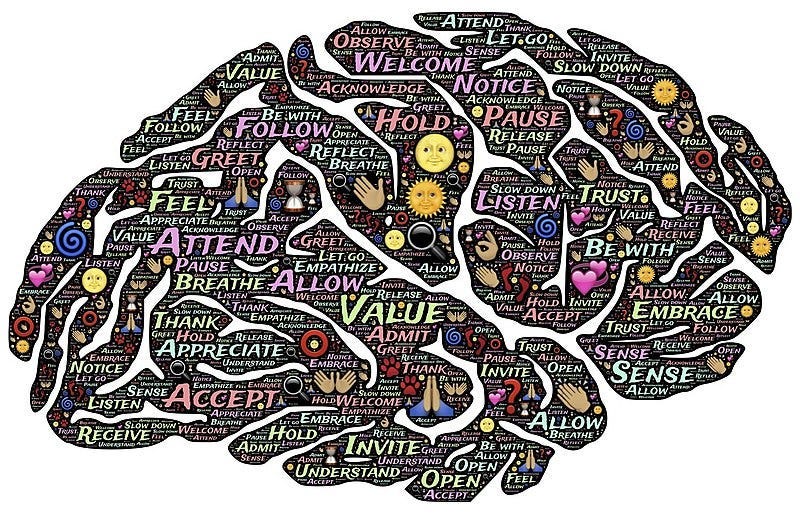Stoicism and Mindfulness: Several Overlooked Aspects
it’s just as important to fill your mind as it is to empty or observe it
As many people have pointed out, there is some degree of overlap between Stoicism and the variety of approaches and perspectives that fall under the rubric of “mindfulness”, a vast spectrum that ranges from rigorous and well-researched studies and methods, to watered down, new-agey twaddle peddled by guru-types.
Once we set aside those silly, shallow, trendy kinds of “mindfulness”, and we focus on the stuff that is deeply informed by practices, theories, and traditions of awareness and visualization, we will quickly note commonalities with ancient Stoic philosophy and practices.
Both stress the deliberate use of one’s own mind, and that requires developing some sort of understanding of how that mind works, both experientially through observation, and also drawing on the theory developed by past and present expert practitioners.
One class I teach to undergraduate students about every 3 or 4 semesters is called “Philosophy, Mindfulness, and Life”. We start the class by looking at the contemporary approaches to mindfulness, common practices, underlying ideas, and assumptions. We also look at the general idea of philosophies as ways of life.
Then we shift to the main focus through most of the semester, experientially exploring a selection of different philosophical traditions and schools approached as ways of life. For a few weeks, students read selections from a philosophy’s texts, learn its key ideas, apply its practices, track their moods and thoughts, and reflect on whether experimenting with that approach exerts effects on their life. Mindfulness, awareness, attentiveness, directing the mind, all of these play roles in this process.
I shuffle in different approaches each time I teach the class, but Stoicism is one that always gets its three weeks. Successfully learning about and learning to use Stoicism can be supported by engaging in mindfulness practices as they are typically understood.
Exercising what Epictetus calls attentiveness (prosokhē), or examining and testing appearances, impressions, imaginations (phantasiai) before assenting to them, examining the longer-term structures of habits — all that can be understood as fitting in with mindfulness.
But there’s a different sort of mindfulness that is right at the heart of the Stoic texts we have, one that perhaps gets a bit too short shrift when people wax enthusiastic over “mindfulness”. Sooner or later, you will want to fill your mind up with tools you’ll need on your path of personal development. There’s a practice of mindfulness that does precisely that equally important as the more conventional conception of mindfulness.
If you spend time reading Stoic texts and thinkers, it won’t escape you how often they stress having ideas, as they say, ready at hand, or available within our minds when the situation calls for them. These get labeled by multiple terms, including “opinions”, “judgments”, “sayings”, “precepts”, “principles”, among others. But they’re all matters we need to add to our mental inventory. For that reading, study, and reflection are indispensable. Too exclusively prioritizing mindfulness might actually prove an impediment to the sort of mind-fullness Stoics emphasize.
In the very chapter of his Discourses that is about attention, Epictetus asks “what are the things then to which I ought to pay attention?” The answer is:
First these general principles, and you ought to have them ready at hand [prokheira], and without them neither go to sleep nor rise up, nor drink nor eat, nor mingle with men. — Epictetus, Discourses, 4.12
One should be mindful of these not just at the time reserved for study or meditation, but throughout one’s ordinary daily activities, and that will require that one have developed and reinforced them within one’s mind.
Earlier in the Discourses, where Epictetus made a similar point, telling us to “have thoughts like these ready at hand by night and by day”, he suggests how we can do this: “Write them, read them, make your conversation about them, communing with yourself or saying to another.”
These are techniques for progressively and eventually systematically structuring our minds and hearts around Stoic insights, criteria, distinctions, arguments, and applications. And so these activities as well are arguably a certain kind or dimension of mindfulness, not just for the Stoics, but more commonly in ancient philosophy as ways of life.
Right there in classic Stoic teachings there are three key aspects of mindfulness, all too easily overlooked, that are being stressed. We need not just empty or free up our minds, but even more to fill them with philosophical principles. And we can’t just store them away for the proverbial rainy day. We need to be continually turning them over in our minds, so we really understand them when they’re needed. And in a broader sense, we need to keep bringing ourselves back to mindfulness about how important this intellectual labour is to our own personal development.
This piece first appeared in the April 2024 issue of the online magazine The Stoic. If this piece has you now interested in Stoicism, and you would like to know what to read next, this might be helpful for you.
Gregory Sadler is the president of ReasonIO, a speaker, writer, and producer of popular YouTube videos on philosophy. He is co-host of the radio show Wisdom for Life, and producer of the Sadler’s Lectures podcast. You can request short personalized videos at his Cameo page. If you’d like to take online classes with him, check out the Study With Sadler Academy.



